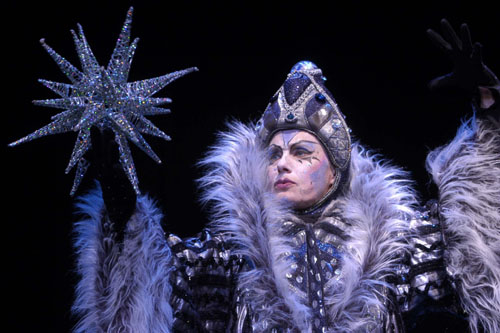The Lion, the Witch,
and the Wardrobe (1950)
Prince Caspian
(1951)
The Voyage of the Dawn
Treader (1952)
The Horse and His Boy
(1954)
The Silver Chair
(1953)
The Magician’s Nephew
(a prequel to the series) (1955)
The Last Battle
(1956)
 |
| The White Witch from the musical Narnia: The Musical Nazareth College Arts Center, 2009 |
Unlike some other classic fantasy literature, these books
have didactic purpose. Lewis had an agenda—to create imagery at the level of a
child’s ability to process that would prepare their hearts and minds for
traditional Christian instruction and traditional Christian character
development.
Lewis was far from believing that witches and fairies and ogres
and other supernatural ephemera were Satanist, evil, or dangerous. Instead, he
presents them as transitional characters to engage children in the processes of
Christianity—forgiveness, compassion, sacrifice (to name a few)—in a manner of
story-telling they can relate to. The great god-lion Aslan is the main guide
for the many children who pass through Narnia and he helps them to understand
sacrifice, death, resurrection, and the glories of heaven.
| Aslan, from Kids Who Care Musical theater, Fort Worth, Texas, 2006 |
Thus, I don’t believe that these stories represent
hero-journey or quest literature, in the classic sense. Tolkien also had a
story-telling agenda, but his more metaphorical rendering of the act of
Christian sacrifice made it entirely more universal as an experience. The
characters in Lord of the Rings are much richer in their suffering and
sacrifice—and they are for an older age group, an age group that supposedly is
more able to deal with a sophisticated narrative. I wish Lewis had trusted his
child audience a bit more.
I love these books. I read them as a teenager and then again
about a year ago as part of my Eager Readers book list quest. As a mature
reader, I found them both more wonderful than ever and also a bit frustrating,
as I was much more aware of the didactic aspect of the texts. I give an unqualified
thumbs up to this set of books and hope you will read them to your children,
read them for your adult self. Even adults need some magic now and then.
Travel with me now, to...
Lewis, C. S., The Lion, the Witch, and the Wardrobe
The first Chronicle of
Narnia, The Lion, the Witch, and the Wardrobe, last read 30 years ago. I
found out after I read it that a different book is considered “first” in some
approaches to Lewis—The Magician’s Nephew.
I’m just going to read them all as I find them.
| The four children and their uncle in front of the wardrobe, Valley Youth Theater |
In LWW, four London
children—Lucy, Edmund, Susan, and Peter—are sent to the country for safety as
so many children were in Great Britain during World War II. The big old house
they stay in is fun to explore and in one of the rooms, Lucy hides in a
wardrobe. There is no back to the wardrobe—beyond the coats are fir trees and
snowy ground. Thus begins the tale of winning back Narnia from the chilling
White Witch. This can only happen when The Four (yes, those four refugee
children) come to the land. The great god-king-lion Aslan can then return and
free the land from years and years of winter (with never a Christmas!).
The plot is a norm now, the standard-bearer for trips to
mysterious places, but it is the characterizations that bring the book to life.
Lucy is sensitive, and brave when it is in the service of others. Edmund is
cranky, never satisfied, a trouble-maker. Susan doesn’t have much personality.
Peter is a Head Boy sort of boy, brave and responsible. It’s nice that the
children stay children, even in Narnia, and respond to events in that way.
| Lucy and Faun http://www.flickr.com/photos/daniellegreveraars /with/1296951186/ |
This series of books has been allegorized to death, so I’m
not going to go that direction. I found this book enjoyable, highly readable,
fast-paced, fanciful, intriguing, scary, funny, and plausible (within its own
assumptions). I liked reading it and it made me eager to read the next one. In
other words, it is a great success as a book. The imagery is beautiful and
meaty—easy to project your stuff onto and to work stuff out. Something to chew
on, in other words. The children learn lessons about themselves and each other.
Sidebar: Narnia The Musical
A few years ago my nephew was in a musical version of
Narnia, called (with great creativity) Narnia: The Musical. Even with the cast’s
fine performances, the musical is a bit flat…but worth a review. The photos in
this blog are from the musical.
The first link here goes to a general site with music
samplings. The second one goes to a series of 20 YouTube videos of all the
songs in performance. Enjoy!
No comments:
Post a Comment